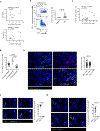A CD4+ T cell population expanded in lupus blood provides B cell help through interleukin-10 and succinate
- PMID: 30478422
- PMCID: PMC6325012
- DOI: 10.1038/s41591-018-0254-9
A CD4+ T cell population expanded in lupus blood provides B cell help through interleukin-10 and succinate
Abstract
Understanding the mechanisms underlying autoantibody development will accelerate therapeutic target identification in autoimmune diseases such as systemic lupus erythematosus (SLE)1. Follicular helper T cells (TFH cells) have long been implicated in SLE pathogenesis. Yet a fraction of autoantibodies in individuals with SLE are unmutated, supporting that autoreactive B cells also differentiate outside germinal centers2. Here, we describe a CXCR5-CXCR3+ programmed death 1 (PD1)hiCD4+ helper T cell population distinct from TFH cells and expanded in both SLE blood and the tubulointerstitial areas of individuals with proliferative lupus nephritis. These cells produce interleukin-10 (IL-10) and accumulate mitochondrial reactive oxygen species as the result of reverse electron transport fueled by succinate. Furthermore, they provide B cell help, independently of IL-21, through IL-10 and succinate. Similar cells are generated in vitro upon priming naive CD4+ T cells with plasmacytoid dendritic cells activated with oxidized mitochondrial DNA, a distinct class of interferogenic toll-like receptor 9 ligand3. Targeting this pathway might blunt the initiation and/or perpetuation of extrafollicular humoral responses in SLE.
Conflict of interest statement
Competing financial interests
Figures




Comment in
-
A CD4+ T cell population provides B cell help in SLE.Nat Rev Rheumatol. 2019 Feb;15(2):63. doi: 10.1038/s41584-018-0150-1. Nat Rev Rheumatol. 2019. PMID: 30552381 No abstract available.
-
Unexpected link between mitochondrial DNA and T cell help in systemic lupus erythematosus.Ann Rheum Dis. 2019 Jun;78(6):e59. doi: 10.1136/annrheumdis-2019-215597. Ann Rheum Dis. 2019. PMID: 31088799 No abstract available.
References
-
- Tsokos GC Systemic lupus erythematosus. The New England journal of medicine 365, 2110–2121 (2011). - PubMed
Publication types
MeSH terms
Substances
Grants and funding
LinkOut - more resources
Full Text Sources
Medical
Molecular Biology Databases
Research Materials
Miscellaneous

